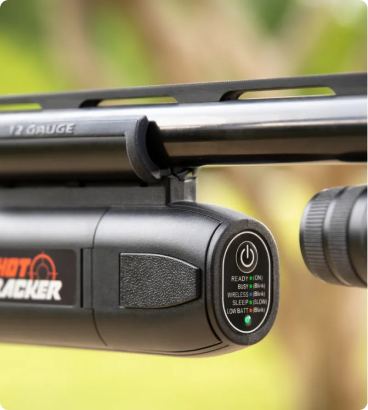Team Training with ShotTracker – Enhancing Group Practice Sessions
Shotgun sports are often team-oriented, whether it’s a high school clay target team, a college club, or just a group of friends who shoot leagues together. Training a team introduces dynamics that individual practice doesn’t – coaches need to give attention to multiple people, and shooters can learn from each other’s successes and mistakes. ShotTracker, known for helping individual shooters, can also be a game-changer in a team training context. It provides a structured way to gather feedback on each shooter and promotes a culture of data-driven improvement throughout the squad.
Integrating ShotTracker into Team Practice
In a typical team practice, shooters rotate through stations or take turns shooting rounds. With one or a few ShotTracker devices, a coach can assign the units to specific stations or shooters each round. For example, in a trap team of five shooters, you might attach ShotTracker to one shooter’s shotgun for the first round and then move it down the line in subsequent rounds. This way, by the end of practice, everyone’s had a “turn” with the device and collected some data on their performance. The real-time feedback can be shared aloud if beneficial – some teams actually call out ShotTracker insights during practice (“You were a bit behind on that one, according to the app”) so that the shooter can adjust on their next attempt. It’s important to ensure that using the device doesn’t slow down the flow; typically, ShotTracker works in the background, logging data without needing to pause between shots, so the cadence of a team practice can remain the same.
Comparative Analysis and Group Learning
A powerful aspect of team environments is peer learning. ShotTracker can facilitate constructive comparisons in a positive way. After practice, a coach might gather the team and review certain data from the session. For instance, if the device was used by multiple shooters on the same station, you could display how each shooter’s muzzle trace looked on a particularly tricky target. Perhaps Shooter A consistently had a smoother follow-through than Shooter B, resulting in higher success. By seeing this comparison, Shooter B can learn visually from a teammate’s example, and Shooter A gets recognition for a job well done (which reinforces their good habit). Important: The goal is not to shame anyone for lower performance; rather, it’s to say “look, we can all learn from each other.” The data adds an objective layer to this – it’s not personal critique, it’s just numbers and lines that everyone can strive to improve together.
Moreover, team members can take inspiration from each other’s progress. If one shooter’s data shows a big improvement in, say, reaction time, they can share what practice or drills they did to get there. This openness creates a collaborative environment where everyone is pulling each other up. ShotTracker basically provides the talking points and evidence needed to have these fruitful discussions.
Friendly Competition and Motivation
Teams often thrive on a bit of internal friendly competition. ShotTracker’s metrics allow you to create mini-challenges that can be both fun and developmental. For example, you might challenge the team: “Who can achieve the highest average muzzle velocity (swing speed) on station 4 today?” or “Let’s see who can string the most consecutive perfect leads according to the data.” Because these metrics are tracked, you can actually have a leaderboard for things other than just score. A shooter who might not always break the most targets could still excel in a metric like reaction time or smoothness, giving them a moment to shine and motivation to push themselves. The key is keeping it fun and encouraging – perhaps the “winner” of a ShotTracker challenge gets a small prize or just bragging rights. This kind of data-driven competition keeps practice lively and engages athletes who are analytically minded. It also underlines that every aspect of technique counts, not just the final score.
Efficiency for Coaches
From a coach’s perspective, managing a team means trying to give each athlete personalized feedback – a tough task when time and attention are split. ShotTracker can act as an assistant coach by logging details for each shooter that the coach might not catch in real time. After practice, a coach can review each shooter’s data. It might reveal, for instance, that two team members are both struggling with late trigger pulls (perhaps indicated by consistently long reaction times on targets). The coach can then plan the next practice to include a drill specifically addressing that issue for those shooters, or even pair those two athletes to work together on improving their reaction under time pressure. In essence, the data ensures no one’s challenges slip under the radar. Even if a coach couldn’t observe every shot of every team member, they have a record to consult and base their guidance on.
Additionally, keeping data over a season for each team member allows a coach to track who is improving and who might be plateauing. Early intervention for those in a slump can maintain overall team performance high. It also provides a factual basis for decisions, such as forming squads or choosing event lineups. For example, if two shooters are vying for a varsity spot, their performance metrics (not just raw scores) might inform the decision – one shooter may have slightly lower scores but more consistency and better fundamentals per the data, suggesting they might perform better under pressure. Coaches can use this information to make fair, transparent decisions, which in turn keeps team morale up because athletes understand selections are based on merit and numbers, not favoritism.
Adapting Devices for Team Logistics
One practical aspect of team use is equipment management. If a team can only afford one ShotTracker, that’s okay – as described, it can be rotated. Teams that can budget for multiple units might assign them to every shooter during practice, but even then, managing the data (making sure each shooter’s shots are logged to their profile) is important. It’s helpful to have a team data manager role – sometimes a coach, sometimes a tech-savvy team member – who ensures after each session that data from the devices is correctly saved and attributed. Many apps allow exporting data, which could then be compiled into a team report. Doing so weekly can show the team’s overall progress. Imagine presenting a graph at a team meeting that shows, “As a team, our average trap score moved from 18 to 22 over the season, and our average reaction time improved by 0.2 seconds.” That reinforces a collective sense of accomplishment.
Safety and attention must still come first. Coaches should ensure that fiddling with the app or device doesn’t distract shooters on the line. Typically, one can wait until the round is over to review what ShotTracker captured, so the flow and focus of live firing remain intact. Clear guidelines on when to look at the phone/tablet screen (perhaps only between rounds or during a break) will keep everyone safe and on-task.
Conclusion
When used thoughtfully, ShotTracker can be a unifying force in team practices. It turns subjective aspects of shooting into objective data that the whole team can rally around. From fostering peer learning and healthy competition to helping coaches tailor their coaching, the benefits extend to every member of the group. Team-based training with ShotTracker creates an environment where improvement is quantifiable and shared – every shooter isn’t just working in isolation but contributing to a bigger picture of team progress. The result is a team that grows together, armed with both the camaraderie of group work and the precision of cutting-edge feedback.




